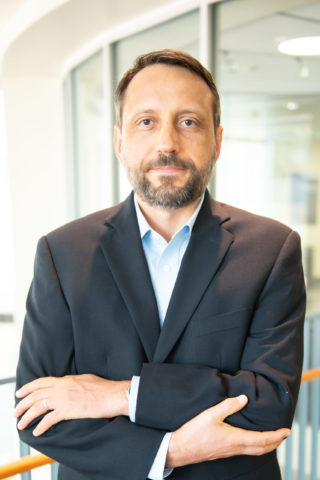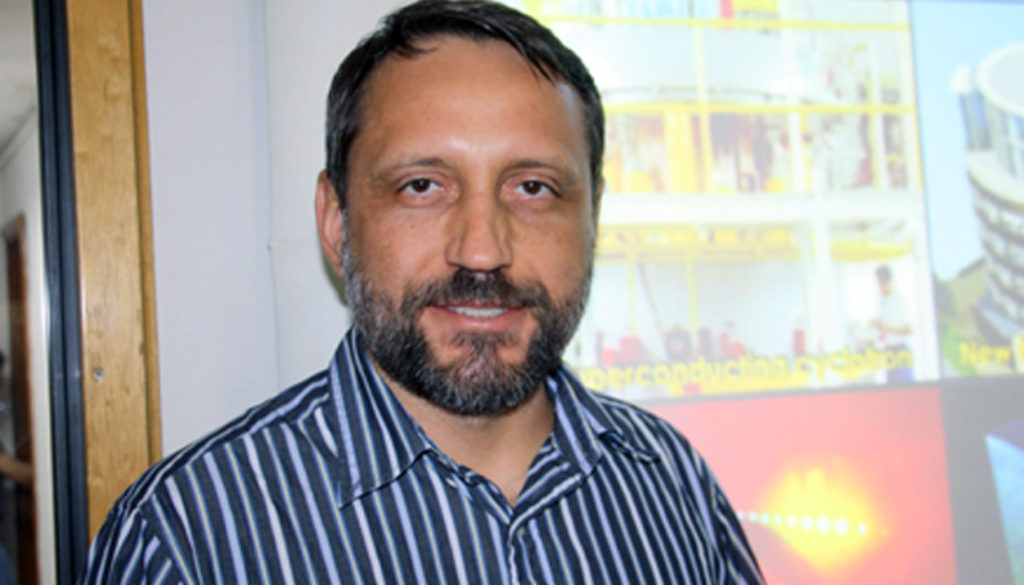Texas A&M Physicist Alexei Sokolov Recognized With 2020 Lamb Award
Dr. Alexei V. Sokolov, professor of physics and astronomy at Texas A&M University, has been selected as a co-recipient of the 2020 Willis E. Lamb Award for Laser Science and Quantum Optics in honor of outstanding contributions to the field.
Established in 1998, the award pays tribute to the famous laser scientist Willis E. Lamb Jr., whose many seminal insights in multiple areas of physics and technology were recognized with the 1955 Nobel Prize in Physics among other prestigious accolades. It is presented annually at the Winter Colloquium on the Physics of Quantum Electronics (PQE), held in Snowbird, Utah, in early January and featuring the world’s top experts in laser physics and quantum electronics.
Sokolov joined the Texas A&M Department of Physics and Astronomy faculty in 2002 and is a key player in Texas A&M’s world-class quantum optics group within the Institute for Quantum Science and Engineering (IQSE). He is widely recognized for his experimental expertise in fields ranging from laser physics and nonlinear optics to ultrafast science and spectroscopy.

Sokolov is the third Texas A&M physicist to earn the Lamb Award, joining Texas A&M Distinguished Professors Dr. M. Suhail Zubairy, a 2014 co-recipient, and Dr. Olga Kocharovskaya, one of three inaugural awardees in 1998. He was presented with his award during a January 5 reception in Snowbird as part of PQE-2020 marking the event’s golden jubilee, where he was cited “for opening the field of molecular modulation with applications to molecular spectroscopy.”
“Lamb was a towering figure in 20th century science,” said Texas A&M Distinguished Professor of Physics and IQSE Director Dr. Marlan O. Scully, who founded the PQE and also worked with Lamb to develop the first quantum theory of the laser. “He was a consummate experimentalist and theoretician. He carried out fundamental experiments that opened the door to modern quantum field theory and, indeed, much of modern science. Furthermore, he deeply understood his experiments and carried out theoretical calculations in detail that explained subtle points associated with his experiments.
“Alexei Sokolov is a man after Willis Lamb’s own heart. Alexei invented a technique for using molecular oscillations to produce new intense combs of light frequencies. Furthermore, he has used these coherent molecular oscillations to advantage in experiments ranging from detecting anthrax-type endospores at range and improving the precision of spectroscopy, to what has been referred to in the literature as ‘incredible precision.’ Clearly, Alexei is the sort of person that young people aspire to emulate and senior scientists admire.”
In a rare full-circle, professional-meets-personal moment, Sokolov was celebrated in tandem with his graduate adviser, Stanford University’s Dr. Stephen E. Harris, and the University of Maryland’s Dr. Christopher R. Monroe — fittingly described in the conference program as “the three gurus of time in modern physics.” Sokolov earned his doctorate in physics from Stanford in 2001 and served as a research assistant in the Edward L. Ginzton Laboratory under Harris’ supervision. As a graduate student at Stanford, Sokolov investigated quantum coherence effects in molecular systems, which led to efficient generation of short pulses of light — expertise he brought with him to Texas A&M upon completion of his doctoral studies.
“This award is a great honor and a confirmation that I am doing important research that may be of interest to my colleagues — physicists, chemists and biologists,” said Sokolov, the inaugural holder of the Stephen E. Harris Professorship in Quantum Optics he helped establish at Texas A&M in 2003 in his mentor’s honor. “This award is particularly special to me, because I am sharing it with my Ph.D. adviser Steve Harris. This man — a great scientist, with no exaggeration — played a huge role in my scientific track. Joining his group at Stanford for me was a serendipitous life-altering event, with an overall impact comparable only to getting admitted to MIPT [the Moscow Institute of Physics and Technology].”
Sokolov’s current research interests center around applications of molecular coherence to quantum optics, ultrafast laser science and technology, including generation of sub-cycle optical pulses with prescribed temporal shape and studies of ultrafast atomic, molecular and nuclear processes, as well as applications of quantum coherence in biological and defense-oriented areas. A fellow of the American Physical Society (2015) and Optical Society of America (2009), he has served as an adviser to the Texas A&M student chapter of OSA since its inception in 2008. And much like Harris, he is renowned as an adviser and mentor to dozens of his own award-winning postdoctoral and graduate students.
“Alexei’s contribution to our graduate program in the Department of Physics and Astronomy is enormous,” said Dr. Grigory Rogachev, professor and head of Texas A&M Physics and Astronomy. “I lost count, but the last time I checked, he had eight graduate students in his group, on top of the countless others who have already graduated.”

In addition to earning selection in 2017 as one of Texas A&M’s inaugural Presidential Impact Fellows, Sokolov’s many career honors include the Texas A&M Research Foundation Board of Trustees JoAnn Treat Research Excellence Award (2011), the Texas Section of the American Physical Society’s inaugural Robert S. Hyer Award (2007), the OSA’s Adolph Lomb Medal (2003) and a Research Corporation for Science Advancement Research Innovation Award (2003). He also holds a patent related to his groundbreaking work with the IQSE to develop a new approach to detect biochemical molecules using an adapted form of Coherent Anti-Stokes Raman Spectroscopy, known as FAST CARS.
Learn more about the Willis E. Lamb Award or the history of the PQE.
Find additional information on Sokolov and his research.
# # # # # # # # # #
About Research at Texas A&M University: As one of the world’s leading research institutions, Texas A&M is at the forefront in making significant contributions to scholarship and discovery, including in science and technology. Research conducted at Texas A&M generated annual expenditures of more than $922 million in fiscal year 2018, ranking the university among the top 20 in the National Science Foundation’s most recent Higher Education Research and Development survey. Texas A&M’s research creates new knowledge that provides basic, fundamental and applied contributions resulting, in many cases, in economic benefits to the state, nation and world. To learn more, visit Research@Texas A&M.
-aTm-
Contact: Shana K. Hutchins, (979) 862-1237 or shutchins@tamu.edu or Dr. Alexei V. Sokolov, (979) 845-7733 or sokol@physics.tamu.edu
The post Texas A&M Physicist Alexei Sokolov Recognized With 2020 Lamb Award appeared first on Texas A&M College of Science.
